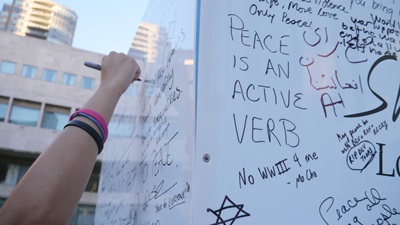
The overhanging clouds on the morning of September 20th made many, who were anxiously waiting for the opening of the Lantern Floating site at the Lincoln Center, worried. Yet, a concern for a rain or wind storm faded away by noon. The sky opened up in blue, characteristic of early fall, as if to welcome thousands of people to share their prayers and wishes for peace as they received their lanterns. People of varied ages and ethnic backgrounds sat at picnic tables in the shady grove while quietly making their lanterns alone or joyously creating them with family and friends.
For the third consecutive year, Shinnyo-en Foundation and the Center for Information on Religion (CIR) in Tokyo invited a small group of distinguished scholars to the Lantern Floating for Peace Ceremony in New York City. For the sake of creating a more harmonious world, the Foundation uses this Lantern Floating ceremony to support the Shinnyo-en Order in reaching out to the larger public and promoting global awareness of Buddhism and other religions.
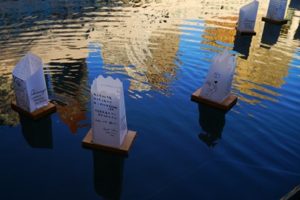 This year’s guests were Dr. Uriah Kim, Academic Dean of Hartford Seminary and a Hebrew Bible scholar; Dr. Ryan Richard Overbey, 2013-2015 Shinjo Ito Post-Doctoral Fellow in Buddhist Studies at UC Berkeley and currently a visiting professor of Religious Studies at Wesleyan College; and Dr. Mario Poceski, an associate professor of Buddhist studies and Chinese religions at the University of Florida.
This year’s guests were Dr. Uriah Kim, Academic Dean of Hartford Seminary and a Hebrew Bible scholar; Dr. Ryan Richard Overbey, 2013-2015 Shinjo Ito Post-Doctoral Fellow in Buddhist Studies at UC Berkeley and currently a visiting professor of Religious Studies at Wesleyan College; and Dr. Mario Poceski, an associate professor of Buddhist studies and Chinese religions at the University of Florida.
After taking in the scene of thousands of lanterns floating in the Paul Milstein Pool at Hearst Plaza, Lincoln Center, guests were ushered to make their own lanterns at their seats and observe the evening Lantern Floating Ceremony. Guests left feeling “jazzed up” from the exquisite music and dance performances during the Ceremony and the inspiring speech delivered by Her Holiness Shinso Ito, the Head of Shinnyo-en Buddhism.
Upon returning to their respective schools, each scholar submitted a short essay to be compiled into a small booklet. Below are excerpts from our guests.
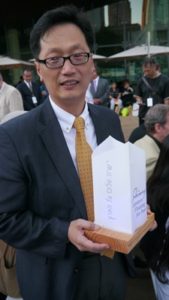 “As a Biblical scholar, whose expertise is in the Hebrew Bible (also known to Christians as Old Testament and to Jews as Tanakh or Torah), the first thought that came to my mind when I reflected on the lantern floating on the water was an advice that a wisdom teacher gave to his students over two thousand years ago. Qohelet (the name that is given to this wisdom teacher by scholars) said, “Cast thy bread upon the water, for thou shall find it after many days” (Ecclesiastes 11:1; King James Version). We can easily associate the bread with shalom since it represents concretely what a person needs to experience shalom and the bread often symbolizes shalom in the Hebrew Bible. But why cast the bread (or shalom) upon the water? The person is making an investment on shalom, and it takes an effort or work to put the bread upon the water. As Her Holiness Shinso Ito said in her message, ‘In tonight’s ceremony, we not only write a message on the lantern, but we take that lantern, place it on the water, and put a little bit of physical effort – a push.’ She continued, ‘That little push reminds us that having good thoughts and intentions is not sufficient. We have to act, in a practical, physical way … little by little in our everyday life, to bring our ideals into reality.’ At first, when we remain focused on the first half of Qohelet’s statement, it sounds altruistic: to cast the bread upon the water and hope for someone else to pick it up and nourish themselves and their families. This seems to agree with the teaching of Shinnyo-en: to give oneself and one’s resources for the benefit of others. Qohelet’s call for an investment in shalom, however, is not completely altruistic. He reassures his students that the investment of shalom they make will be returned to them in the future. He clarifies his teaching in the next verse, ‘Give a portion [of one’s possession or bread] to seven, and also to eight; for thou knowest not what evil shall be upon the earth’ (Ecclesiastes 11:2; King James Version). The idea is that people who have benefited from our philanthropy or charity might help us in times of need and trouble. This is a practical guide for those who are well-to-do to secure their shalom in the future. But we shouldn’t dismiss Qohelet’s advice for its lack of altruism. It is important for all of us to realize that our investment in the shalom of others is also an investment of our own shalom in the future.” – Uriah Kim
“As a Biblical scholar, whose expertise is in the Hebrew Bible (also known to Christians as Old Testament and to Jews as Tanakh or Torah), the first thought that came to my mind when I reflected on the lantern floating on the water was an advice that a wisdom teacher gave to his students over two thousand years ago. Qohelet (the name that is given to this wisdom teacher by scholars) said, “Cast thy bread upon the water, for thou shall find it after many days” (Ecclesiastes 11:1; King James Version). We can easily associate the bread with shalom since it represents concretely what a person needs to experience shalom and the bread often symbolizes shalom in the Hebrew Bible. But why cast the bread (or shalom) upon the water? The person is making an investment on shalom, and it takes an effort or work to put the bread upon the water. As Her Holiness Shinso Ito said in her message, ‘In tonight’s ceremony, we not only write a message on the lantern, but we take that lantern, place it on the water, and put a little bit of physical effort – a push.’ She continued, ‘That little push reminds us that having good thoughts and intentions is not sufficient. We have to act, in a practical, physical way … little by little in our everyday life, to bring our ideals into reality.’ At first, when we remain focused on the first half of Qohelet’s statement, it sounds altruistic: to cast the bread upon the water and hope for someone else to pick it up and nourish themselves and their families. This seems to agree with the teaching of Shinnyo-en: to give oneself and one’s resources for the benefit of others. Qohelet’s call for an investment in shalom, however, is not completely altruistic. He reassures his students that the investment of shalom they make will be returned to them in the future. He clarifies his teaching in the next verse, ‘Give a portion [of one’s possession or bread] to seven, and also to eight; for thou knowest not what evil shall be upon the earth’ (Ecclesiastes 11:2; King James Version). The idea is that people who have benefited from our philanthropy or charity might help us in times of need and trouble. This is a practical guide for those who are well-to-do to secure their shalom in the future. But we shouldn’t dismiss Qohelet’s advice for its lack of altruism. It is important for all of us to realize that our investment in the shalom of others is also an investment of our own shalom in the future.” – Uriah Kim
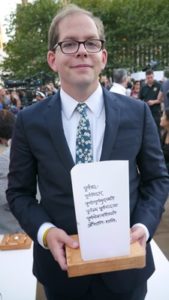 “Beginning in the fifth and sixth centuries, Chinese Buddhist scholars produced many learned commentaries on the Lotus Sūtra. These commentaries had to address the problem of dhāraṇī´. They all defended Kumārajīva’s decision not to translate the dhāraṇī. For scholars like Zhiyi (538‚Äì598), the great founder of the Tiantai tradition, dhāraṇī are actually untranslatable …
“Beginning in the fifth and sixth centuries, Chinese Buddhist scholars produced many learned commentaries on the Lotus Sūtra. These commentaries had to address the problem of dhāraṇī´. They all defended Kumārajīva’s decision not to translate the dhāraṇī. For scholars like Zhiyi (538‚Äì598), the great founder of the Tiantai tradition, dhāraṇī are actually untranslatable …
For Zhiyi the dhāraṇī cannot be translated because each and every word of a dhāraṇī simply has too much meaning. To translate the dhāraṇī is to decide in advance what it might mean, and thus to limit its productive potential.
After listening to the speech of Her Holiness, I realized suddenly how the ritual structure of the Lantern Floating for Peace reflects this old Buddhist lesson about language, meaning, and power. The entire ceremony is about ‘Peace.’ But what does ‘Peace’ actually mean? How do we define ‘Peace’? Shinnyo-en wisely chooses not to make a decision in advance. Instead, the ceremony brings people from a huge variety of cultural and religious traditions and invites them to define and to enact their own visions for peace. Each person inscribes their own lantern-their own translation of this powerful and enigmatic word “Peace” – and sends out their lantern into the world with intention. We might at first think that the word ‘Peace’ is impossibly vague, but then we see how this indeterminacy gives us space to create peace in ways that are meaningful for us and our communities. For some, peace is about politics and conflict – we wish for ‘Peace in the Middle East’ or ‘Peace for the World.’ For others, the word ‘Peace’ calls us to reflect upon our departed friends and family, and to express our love for them. For still others, ‘Peace’ is about delicious ice cream!
In this way the word ‘Peace’ functions much like an ancient Buddhist dhāraṇī. The Shinnyo Lantern Floating ceremony utters the word ‘Peace’ without settling on a single meaning in advance. And when ‘Peace’ is uttered in this way – in a way that gives an entire community room to come together and express their diverse visions for an ideal world – we begin to learn how powerful words can be.” – Ryan Richard Overbey
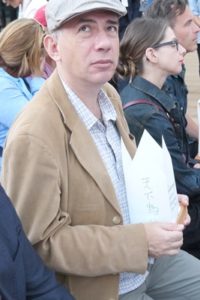 “The image of floating lanterns comes from traditional Japanese culture. The popular ceremony that features the floating of lanterns in bodies of water, especially rivers, has strong Buddhist connotations and is closely linked with the commemoration of the departed, especially one’s ancestors. Often the floating ceremony is done towards the end of the Bon festival, with the beautiful light emanating from the lanterns meant to guide the souls of the departed on their journey into the netherworld. In that context, the central element of the ceremony hearkens back to cherished cultural ideals and long-established practices, closely associated with Buddhism, that have high currency in Japan.
“The image of floating lanterns comes from traditional Japanese culture. The popular ceremony that features the floating of lanterns in bodies of water, especially rivers, has strong Buddhist connotations and is closely linked with the commemoration of the departed, especially one’s ancestors. Often the floating ceremony is done towards the end of the Bon festival, with the beautiful light emanating from the lanterns meant to guide the souls of the departed on their journey into the netherworld. In that context, the central element of the ceremony hearkens back to cherished cultural ideals and long-established practices, closely associated with Buddhism, that have high currency in Japan.
In contrast to the culture-specific imagery associated with the floating lanterns, the notion of peace have universal connotations. In the most general – and perhaps also somewhat hackneyed – sense, it denotes the absence of armed conflict, especially destructive wars that pit different armies or nations against each other. On a less dramatic level, the notion of peace can point to the prospect of more tranquil, thoughtful, and cooperative patterns of inter-human interactions, which can occur at different levels and in all sorts of circumstances. Finally, there is the prospect of inner peace, which is perhaps where Buddhist truly comes into play. Of course, inner peace can also have a positive impact on external peace, so in that sense the personal cultivation of inner peace can have broader social and political ramifications. In fact, one of the central themes of the main ceremony, which was implicitly integrated into the whole proceedings, was the notion that there is a close connection between inner and outer, or individual and world peace. The next step, I think, is to make it more explicit how Buddhist beliefs and practices, which at certain point move beyond the mundane realm and open up a link with the transcendental, can contribute to the establishment of peace and serenity within the human heart, which can then be shared with others.” – Mario Poceski
As the above excerpts attest, the guests interwove their rich knowledge and wisdom of a chosen field into their impressions of the Lantern Floating. In the coming months, the booklet with their essays at their entirety will be published and made available to the public, thanks to the editorial work of Dr. Kenta Kasai of CIR. Please contact Dr. Kasai at kasai@circam.jp or Ineko Tsuchida at itsuchida@sef.org if you are interested in obtaining the booklet. We hope that the scholars’ deep perspectives into “the Shinnyo Lantern Floating for Peace” further invigorates your pursuit for peace.
For more information on “the Shinnyo Lantern Floating for Peace,” please visit the Shinnyo-en Global Website.
Photo credits: Christine Eslao
